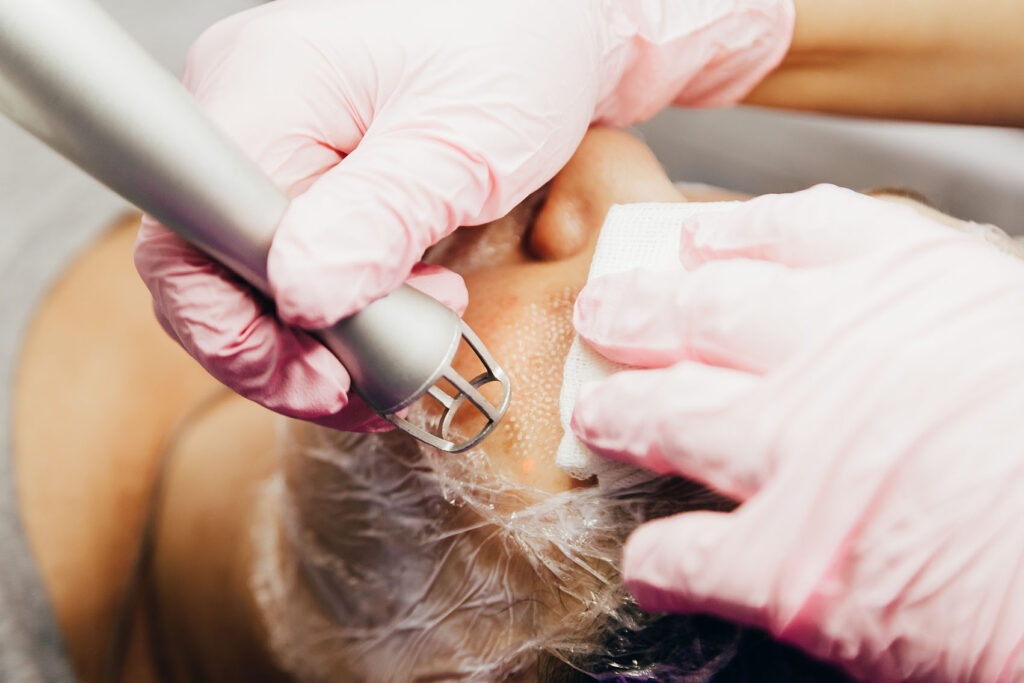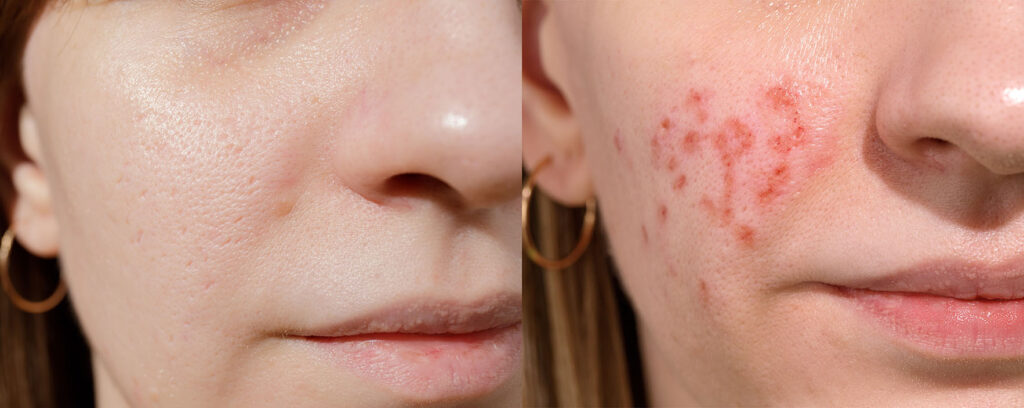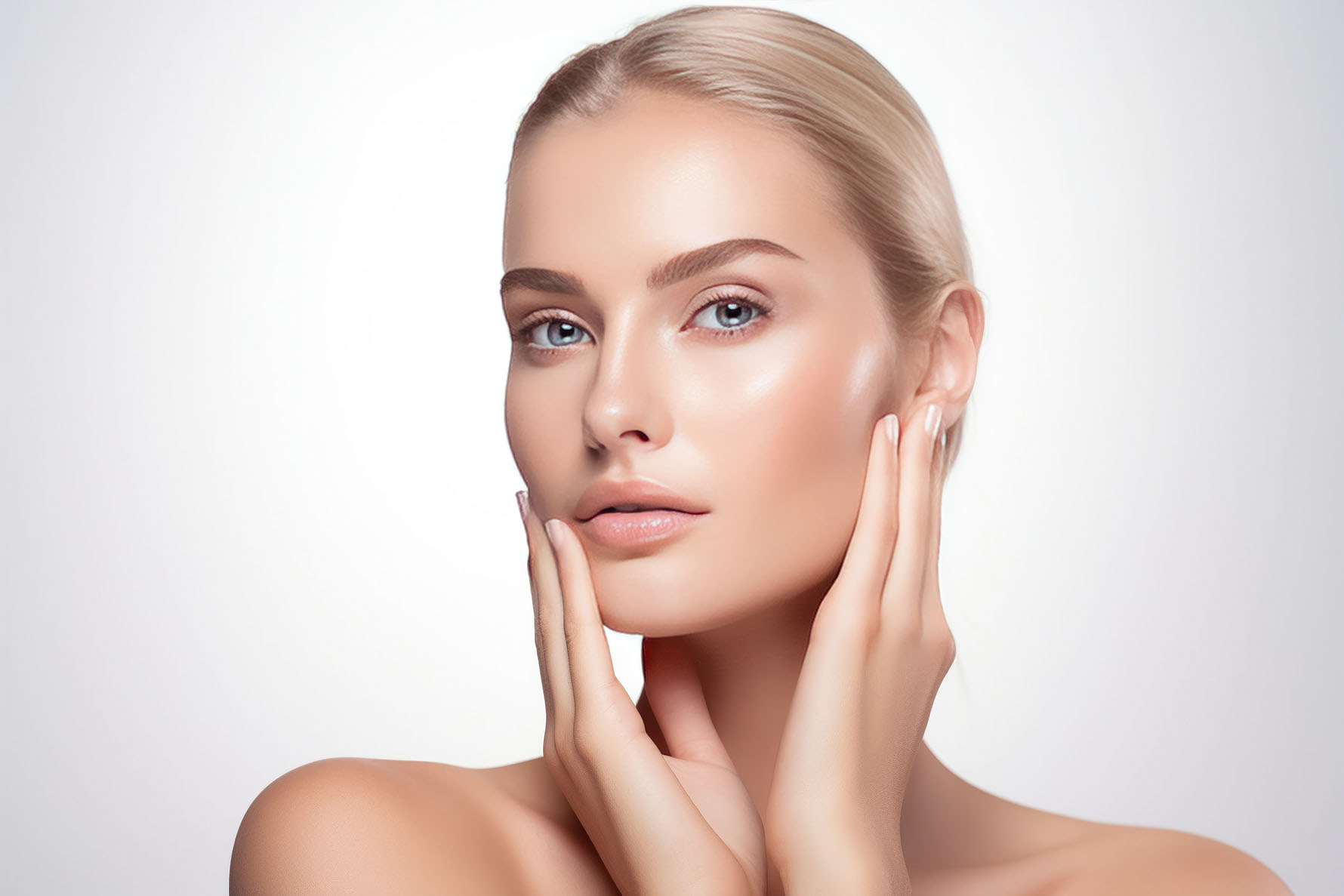Imagine pressing pause on time, not with filters or fillers, but with light.
You glance in the mirror and see smoother texture, softened lines, and a luminous tone that feels like your skin finally caught up to how youthful you feel inside. This isn’t fantasy, it’s the refined power of laser skin resurfacing.
But with so many options, especially when it comes to CO₂ and Erbium lasers, how do you choose the right path for your skin? The truth is, both technologies can beautifully rejuvenate your skin. The difference lies in depth, downtime, and your personal goals.
Today, we’ll walk you through the science, the subtleties, and the real-world results behind each option, so you can make an informed, empowered choice with your May Aesthetics provider.
What Is Laser Skin Resurfacing?
Laser skin resurfacing is a clinically advanced treatment that uses focused light energy to gently remove the outermost layers of skin while stimulating your body’s natural collagen production. The result? Smoother texture, softened wrinkles, faded sun damage, and renewed radiance.
At May Aesthetics Boutique, we specialize in fractional and ablative resurfacing techniques using trusted, medical-grade lasers. Whether you’re addressing years of sun exposure, acne scarring, or the natural changes that come with aging, laser resurfacing offers a powerful yet elegant solution, no injectables required.
Unlike traditional exfoliation or peels, laser technology can precisely reach deep into the dermis, targeting the root of skin concerns rather than just the surface. Think of it as restoring the architecture of your skin, one pulse of light at a time.

How Does Fractional CO₂ Laser Resurfacing Work?
CO₂ laser resurfacing has long been considered the gold standard for advanced skin rejuvenation, and for good reason. Using carbon dioxide energy at a wavelength of 10,600 nm, this treatment deeply ablates damaged skin layers while triggering an intense healing response beneath the surface.
But what sets fractional CO₂ apart is its innovative delivery. Instead of removing the entire surface, it treats tiny columns of skin in a grid-like pattern. This fractional approach allows healthy skin to remain intact between treated areas, which speeds healing and minimizes risks compared to fully ablative techniques.
Fractional CO₂ is particularly suited for:
- Pitted acne scars
- Deep-set wrinkles and etched-in lines
- Severe sun damage or leathery skin texture
- Aging skin that’s lost elasticity or bounce
However, it’s important to understand that with this depth comes significant downtime. Expect redness, crusting, and peeling for up to 10–14 days, along with strict aftercare. For the right candidate, the results are dramatic, but it’s not a casual weekend treatment. It’s an investment in long-term skin integrity and visible transformation.
How Does Erbium Laser Resurfacing Work?
If fractional CO₂ is the deep sculptor of skin, Erbium: YAG laser is its precision artist. Using a water-absorbing wavelength of 2,940 nm, Erbium laser resurfacing gently vaporizes the outermost skin layers with remarkable control and minimal heat diffusion. This precision allows for effective resurfacing with less inflammation, less risk of pigment change, and a noticeably shorter recovery time.
At May Aesthetics Boutique, we use Erbium YAG technology to refine fine lines, smooth rough texture, and brighten overall tone. It’s an ideal choice for clients seeking:
- Subtle, natural refinement
- Mild to moderate acne scarring
- Enlarged pores or dullness
- Early signs of aging or uneven tone
- A safer option for Fitzpatrick skin types III–V
Unlike CO₂, which penetrates deeper and requires more healing time, Erbium allows you to return to your routine within 3–7 days, depending on the depth of treatment. It’s a client favorite in Middleburg and Warrenton, particularly for those balancing a busy lifestyle with a desire for results that don’t compromise safety or elegance.
Our lead laser specialist, Kelli, often recommends Erbium resurfacing for first-time clients or those looking to refresh their skin after summer sun exposure without the risk of post-inflammatory hyperpigmentation.
Fractional vs. Fully Ablative Lasers: What’s the Difference?
This distinction is at the heart of modern laser resurfacing: how much of the skin is treated at once, and how that affects your healing.
Fully ablative lasers (like traditional CO₂) remove the entire outer layer of skin in the treated area. While powerful, this approach requires a longer healing period and carries a higher risk of side effects like prolonged redness or pigmentation, especially in darker skin tones.
Fractional lasers, on the other hand, treat microscopic columns of skin, leaving surrounding tissue intact. This preserves your skin’s healing ability while still stimulating deep collagen remodeling, a win-win for many clients.
Here’s how we think about it at May Aesthetics:
“Fractional delivery lets us offer meaningful change without pushing your skin past its limits,” says Kelli, who customizes every resurfacing session based on your skin type, treatment history, and tolerance for downtime.
Choosing between the two isn’t just about depth; it’s about your comfort level, recovery window, and long-term skin goals. During your consultation, we’ll guide you through these choices with honesty and precision.
Which Laser Works Best for Acne Scars and Wrinkles?
Both lasers can support your skin’s healing, but they speak different “languages” when it comes to scars and signs of aging.
If you’re struggling with deep acne scarring, etched-in wrinkles, or laxity, fractional CO₂ may be your best ally. Its ability to penetrate the dermis triggers robust collagen remodeling that improves pitting, skin thickness, and texture over time.
But for textural irregularities, surface scars, or fine lines, Erbium’s precision and reduced thermal injury often deliver a more refined result, especially for sensitive skin or those prone to hyperpigmentation.
Think of CO₂ as renovation and Erbium as restoration. Both are powerful. The question is: What does your skin need right now?
At May Aesthetics, we often integrate acne scarring treatment into long-term skincare programs like our Acne Bootcamp, where laser resurfacing is paired with clinical skincare guidance, Face Reality protocols, and collagen-supportive supplementation.
Which Laser Is Safer for Darker Skin Tones?
When it comes to laser treatments, skin tone matters, not just for results, but for safety. The Fitzpatrick Skin Type Scale helps providers assess how much pigment (melanin) is in your skin and how likely it is to react to heat, inflammation, or injury.
CO₂ lasers, while incredibly effective for collagen remodeling, carry a higher risk of post-inflammatory hyperpigmentation (PIH) in Fitzpatrick types IV–VI due to the intensity of thermal energy they deliver. That’s why at May Aesthetics, we only recommend fractional CO₂ for lighter skin tones (Fitzpatrick I–III) or when we’ve built skin tolerance through pretreatment care.
Erbium lasers, by contrast, produce less heat and more superficial ablation, making them safer for medium to deep skin tones when customized correctly. Erbium’s water-absorbing wavelength means less risk of pigment disruption, especially important for our diverse Virginia-based clientele in Haymarket, Gainesville, and Warrenton.
“Our job isn’t just to resurface skin, it’s to protect it,” says Kelli. “For clients with melanin-rich skin, we tailor laser settings conservatively and always prioritize long-term skin health over fast results.”
Your safety is our standard, not a variable. Every resurfacing consultation includes a Fitzpatrick assessment, lifestyle review, and skincare prep to ensure the smoothest, safest outcome possible.
What’s Downtime and Recovery Like?
Laser resurfacing is powerful, but it’s not instant. Both CO₂ and Erbium treatments require a period of post-treatment healing, which we’ll guide you through every step of the way.
CO₂ Laser Recovery (7–14 days):
- Initial oozing and crusting (24–48 hours)
- Intense redness and peeling for 5–10 days
- Sun sensitivity for several weeks
- Requires strict barrier protection and SPF
This downtime is deeper, but so are the results. Most clients take a week off from work and social events.
Erbium Laser Recovery (3–7 days):
- Redness, swelling, and dry peeling
- Skin feels tight, sometimes itchy
- Light flaking around day 3–5
- Easier to conceal with breathable mineral SPF
Whether you choose Erbium or CO₂, aftercare is everything. We offer curated post-laser recovery kits through our online shop, featuring Skinbetter’s Alto Advanced, Hydrinity’s barrier repair serums, and Colorescience SPF for protection without irritation.
Olivia often reminds clients, “Your skin is rebuilding from the inside out. Give it what it needs: hydration, rest, and clinical-grade support.”
If you’re combining your laser session with hormone optimization or peptide therapy, our wellness provider Sonya can guide you in accelerating collagen recovery from the inside.
Comparison Table: CO₂ vs. Erbium Laser Resurfacing
| Feature | CO₂ Laser | Erbium: YAG Laser |
| Depth of Penetration | Deeper ablation into the dermis | Superficial to moderate precision resurfacing |
| Ideal For | Acne scars, etched wrinkles, thick texture | Fine lines, sun spots, mild scarring |
| Skin Types | Best for Fitzpatrick I–III | Safe for Fitzpatrick III–V |
| Downtime | 7–14 days (more intense) | 3–7 days (gentler recovery) |
| Heat Output | Higher, with greater contraction | Lower, safer for pigment-prone skin |
| Results | Dramatic, long-term collagen remodeling | Subtle, natural refinement |
| Pain Management | Requires topical numbing + downtime | Often, just topical numbing |
| Frequency | 1–2 sessions per year | Can be done in series for progressive glow |
Think of CO₂ as the dramatic renovation and Erbium as your architectural refresh. Both honor your skin’s design, just with different levels of intensity.
Choosing the Right Laser Treatment at May Aesthetics
No two complexions age in the same way, and your skin story deserves more than a one-size-fits-all solution.
At May Aesthetics Boutique, every resurfacing plan is personalized through a clinical-meets-intuitive lens. During your consultation, we’ll assess your skin’s texture, tone, healing capacity, Fitzpatrick type, and desired outcome. Then we match you with the most appropriate modality, whether that’s fractional CO₂, Erbium YAG, or a combination series for layered results.
Our Erbium laser system is a favorite among patients looking for a refreshed glow with minimal downtime. It’s also part of our seasonal reset protocols, where we address summer-induced pigment, dullness, and laxity through carefully timed treatments in the fall and winter.
“Erbium gives us the precision to treat the most delicate areas, eyes, neck, even décolletage, with confidence,” says Kelli, our master esthetician and laser specialist in Middleburg and Warrenton.
If you’ve tried topical skincare with little change, or if you’re noticing a shift in firmness, scars, or overall skin clarity, resurfacing may be your next step. The results aren’t just visible, they’re empowering.

Where Precision Meets Confidence: Your Next Step Starts Here
You don’t need to choose between natural beauty and powerful results. At May Aesthetics Boutique, skin resurfacing is more than a procedure; it’s a moment of reconnection with your most vibrant self.
Whether you’re just beginning your skincare journey or ready to refine long-standing concerns, our team is here to guide you with clarity, compassion, and clinical expertise.
Schedule your consultation in Middleburg or Warrenton, VA, and let us design a treatment plan that reflects your skin’s needs and your lifestyle goals. Because caring for your skin should feel as intentional and luxurious as it looks.
Frequently Asked Questions
Is the Erbium laser better than CO₂?
It depends on your skin type, concerns, and downtime tolerance. Erbium is gentler and better for surface-level concerns or darker skin types, while CO₂ is more intensive for deep wrinkles or scars.
What’s the best laser for acne scars?
For deep, pitted scars, fractional CO₂ offers powerful collagen remodeling. For milder texture issues or combination concerns, Erbium can refine tone and clarity with less downtime.
Can darker skin tones get laser resurfacing?
Yes, with the right modality. The erbium laser is generally safer for Fitzpatrick types III–V. At May Aesthetics, we tailor your plan based on your melanin levels, healing patterns, and history of pigmentation sensitivity.
How long do results last?
Most clients see visible improvement for 12–18 months, especially when supported by medical-grade skincare and sun protection. Maintenance sessions or lighter seasonal treatments may be recommended for an ongoing glow.
Is laser resurfacing painful?
Topical numbing makes both procedures very tolerable. You may feel heat or tingling during treatment and temporary sensitivity post-procedure. Your comfort is always our priority.
